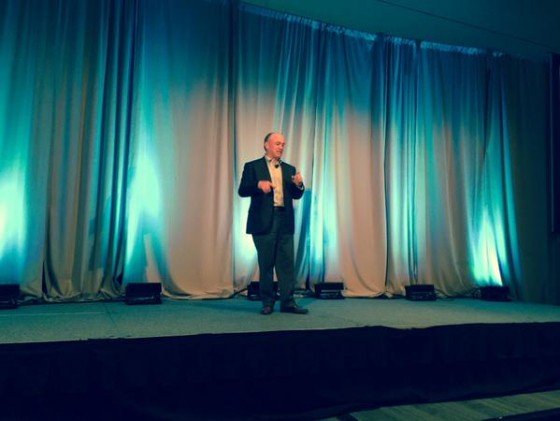Its LiveWorx conference on the Internet of Things has 1,000 more attendees than expected. The yottabytes are coming sooner than you think.
Today’s factories turn digital prototypes into physical products, says PTC CEO Jim Heppelmann. But what becomes of the virtual model after the real one exists? The physical product never connects back to its digital origins. As envisioned by PTC, the emerging Internet of Things is an opportunity to put the digital model back to work after manufacturing, as the digital avatar of all its physical instances.
If appearances at this week’s PTC LiveWorx conference are any indication, PTC has a hit on its hands. PTC made plans for 1,000 attendees, but registration was stopped at 2,000. “We’ve had to tell people, ‘please don’t come, we don’t have any room’” Hepplemann said during an elevator ride the night before the event started. “It is amazing how people are responding.” All events were originally scheduled for the host hotel, but the keynotes had to be moved on short notice to a nearby convention center.

Historically, Heppelmann said during his keynote presentation, the connection between the product and the manufacturer is the warranty card. It is up to the customer to stay connected with the manufacturer. But with the rise of the Internet of Things, manufactured items can communicate with the factory directly. When a gearbox in a tractor is slipping, a sensor can send a message back to its digital self at the manufacturer and to the owner, and a service order can be initiated.
In a mechatronic world, where many products have more lines of code than a smartphone app, products are becoming systems. “There is no clean separation between the physical reality and the digital reality,” Heppelmann said. “We need new technology platforms to work with this reality.”
Another acquisition
A few years ago PTC took a long, hard look at the idea of entering the Internet of Things arena. It decided it would be cheaper to buy the necessary software to become a major player rather than try to build it itself. In 2012-2013 it acquired Axeda and ThingWorx, and today PTC announced the acquisition of ColdLight, which creates software for big data machine learning and predictive analytics. The purchase price was approximately $105 million.
PTC says ColdLight will become PTC’s core data analytics platform, by automating the analysis of data from manufactured products. Examples include detecting failure patterns from data, modeling correlations, prescribing remedies, and prioritizing recommendations against cost constraints. ColdLight’s Neuron platform addresses these challenges by using artificial intelligence and machine learning technology to automatically and continuously learn from data, discover patterns, build validated predictive models and send information to virtually any type of application or technology.
What do we think?
The Internet of Things unleashes a new source of real-time information from a new generation of smart, connected products. But the amount of data will quickly soar: Dan Shey of ABI Research says the data will grow from terabytes today (1,000,000,000,000 bytes) to exabytes by 2020 (1,000,000,000,000,000,000 bytes) and yottabytes by 2035 (1,000,000,000,000,000,000,000,000 bytes). That’s per manufacturer, not the global total. No manufacturer is ready to deal with that kind of data onslaught.
With the rise of social media, some pundits declared every business had to become a media business to stay competitive. The rise of the IoT means every manufacturer has to become a data analysis company to stay competitive. PTC is acquiring and building a toolset that allows a manufacturer to monetize data, to provide a new level of support to customers. All the “things” in the IoT have a lot of important insights to share, but right now they are speaking in a code that only data scientists understand. PTC intends to deliver a new generation of big data analytics tools to make create value from all this new data.





